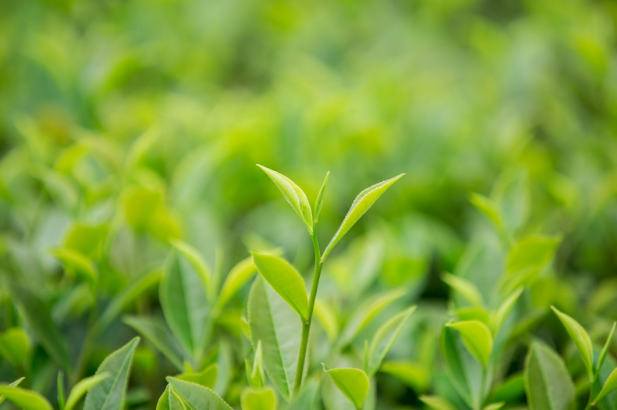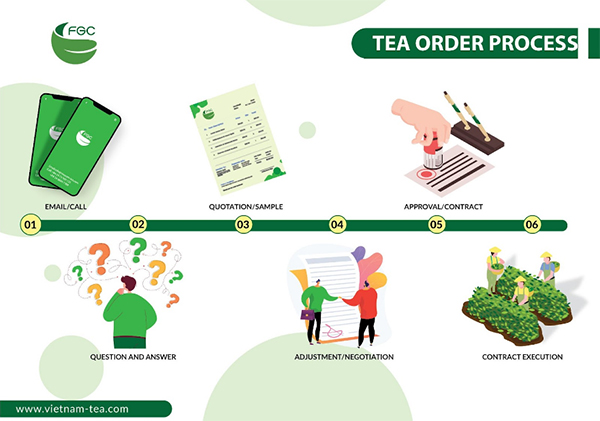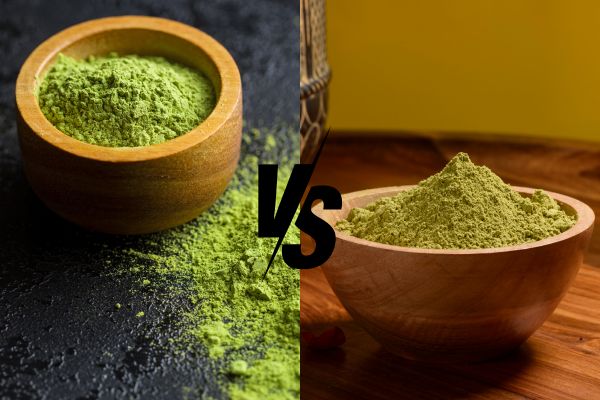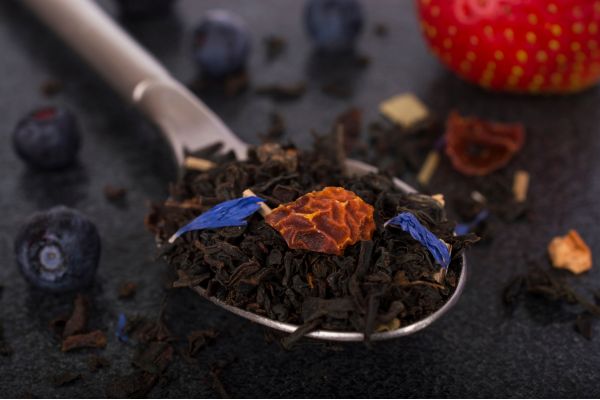Tea tree is one of the perennial industrial plants that bring high and long-term economic value to Vietnam. They are grown in many places, especially thriving in the midland and mountainous areas. Depending on the ecological characteristics and the growing region, Vietnamese tea leaves will have different features. To know more about Vietnamese tea leaves, let’s find out in the following article.

Contents
1. Characteristics of Vietnamese tea leaves
People usually collect Vietnamese tea leaves from bushy tea trees. Characteristics of Vietnamese tea trees are a wide and low canopy with many branches. It is hard to determine their main trunk. The branching position is low, and the levels are equally close.
For ancient tea trees in the high mountains, such as Shan Tuyet, are woody tea trees that are tall, large, big diameter, distinctly high main body, high branching position.

Tea pickers often pick tea buds with tips or without tips (natural bud is full of young leaves and one tea tip) to produce high quality loose leaf teas: black tea FBOP, BOP, OP, Pekoe, green tea OP, Pekoe, Oolong tea. Vietnamese farmers often use older leaves to produce lower quality teas as Black OPA, green Pekoe, and other low-grade teas such as PS, BPS, F, D, etc.
1.1 Green tea leaves
The freshness and kind of green tea leaves determine its quality. It has a relatively high selling price and growing customer demand when compared to black tea. There are different methods of producing Vietnamese green tea, such as Pan-fried green tea, dried green tea, sun-dried green tea, and steamed green tea (using hot steam to prevent oxidation).
Vietnamese green tea leaves are not fermented or oxidized. It is easy to distinguish green tea from other teas through its dry greenish-gray, dark-green, or yellowish-green leaves. When making tea, the infusion is transparent and green or light yellow-green. The tea has a strong taste, slightly astringent, fresh mellow aroma, and smooth aftertaste, almost like the taste of fresh tea leaves.

Currently, the most famous green tea leaves in Vietnam are Thai Nguyen teas such as Móc Câu tea, Nõn tôm tea, Dinh Tan Cuong tea. Besides, there are scented or flavored green teas such as Tay Ho lotus tea, jasmine tea, grapefruit tea, etc.
Types of products: green tea leaves are packed in bulk 30 – 50kg to export, or selling final products in small bags/ boxes or tea bags, etc.
1.2 Black tea leaves
Of all the teas, black tea leaves are the only ones that are fully oxidized. The substances produced in the complete oxidation process are Theaflavin and Thearubigins. When made in the exact ratio, Vietnamese will have black tea with the red color of water and the black color of finished tea leaves. Black tea has a red-brown color like champagne with a more robust taste than other teas.

If green tea leaves are popular in the East, black tea leaves are the most popular tea in the West. After hundreds of years of cultural interference, now black tea (red tea) has become a familiar drink all over the world. Not only a popular drink, but Vietnamese black tea is also an indispensable ingredient in the bartending of coffee shops and milk tea shops. It is used to make fruit-flavored tea or milk tea.
Black tea leaves are packed in bulk 30-50kg to export. For finished products, they are in small bags/boxes or tea bags, etc.
1.3 Oolong tea leaves
Oolong tea has become one of the most famous teas in Vietnam because of its variety, and it is easy to enjoy. Compared to green tea, oolong tea tastes quite acrider but pleasant. Some of the known flavors of oolong are woody, honey, chestnut, etc.
People often say oolong tea is a kind of tea between green tea and black tea because its leaves are half oxidized. The characteristic is different from green tea leaves without oxidation, or black tea leaves being completely fermented. Furthermore, the rolling process is also different in each manufacturing company. It often dictates the final flavor of the tea a lot. Because of these processes, oolong tea is more expensive than a lot of other teas.

Traditional oolong tea leaves are dried and shaped into dark green pellets. However, Vietnamese Oolong tea leaves are black and round pellets. While the infusion of green oolong tea leaves is golden-green, black oolong tea leaves are brown-red. They all have a delightful taste and gentle sweetness more than other types of tea.
Vietnamese oolong tea varieties are purebred type, Kim Tuyen, Tu Quy, Cao Son, and successfully grown in Lam Dong, Moc Chau, Yen Bai, Thai Nguyen. Those places have cold and high moisture all the time. Because of the difference in climate and geography, Vietnamese oolong tea leaves have a distinct aroma and taste compared to other countries.
Oolong tea leaves are packed in 20kg bags in bulk, or small bags/ pouches/ tea bags, etc.
1.4 Pu Erh tea leaves
Pu erh tea leaves are usually baked into cakes or big pellets. Its ingredient is from ancient tea leaves on low temperature high mountains. The brewed tea is red or dark brown, has a decayed wood or smokey flavor, etc.

Pu Erh has two types that are raw Pu-erh and ripe Pu-erh. Raw Pu-erh tea has a simple processing method. After being crushed, it is dried in the sun and then baked. As it does not undergo the process of killing green, the tea enzyme remains, and the tea continues to oxidize while it is stored. Like the Champagne of the West, the older it gets, the rarer it becomes, so Pu-erh tea is. The raw Pu-erh tea leaves have had the best taste for about ten years.
As for the ripe Pu-erh tea, after drying, the tea maker will carry out the fermentation process (piled up and wet brewing) for about 30 to 50 days, then it will be baked. After three years, ripe Pu-erh tea leaves will have the best aroma and sweet aftertaste.
1.5 Shan tea leaves
Shan tea leaves only appear in the high mountains of about 1000-2000m in the North of Vietnam, where the night and day temperatures have a big difference. Because it is surrounded by clouds all year round, it is favorable for the growth and development of high-quality Shan Tuyet tea.
The tea has the name Shan Tuyet because the tea usually has big buds, gray-white color, and the underneath tea leaves have fine white fluff like snowflakes. Vietnamese collect the young leaves and buds of the tea tree to make Shan Tuyet tea.

When brewing tea, the tea buds will gradually bloom with a mild aroma and infusion is golden or natural light yellow like honey.
The tea is clean and safe, so it is good for health because the tea tree is naturally grown on high mountains, not much affected by humans. The buds of ancient Shan Tuyet tea leaves contain more minerals and good medicinal properties than other tea leaves.
Therefore, Shan Tuyet tea leaves are used as a purifying drink to remove harmful substances from the body. In addition, for women, this tea has anti-aging components, brightens the skin complexion, prevents melasma and freckles.
Shan tea leaves are often packed in tin cases 50g, small bags 100g, 200g, tea bags, etc.
1.6 White tea leaves
White tea is one of the most famous teas in Vietnam. People make it from tea buds of tea trees that grow in highlands and low temperatures areas. Its name, White tea, comes from the color of the finished tea leaves is white, surrounded by thin cilia owing to the distribution of tea plants in low-temperature areas.
After being harvested, the tea buds undergo very minimal processing methods of withering and drying, thereby preserving the white color of each tea leaf. Tea leaves are from young buds, are slightly curved, some are elongated. When enjoying Vietnamese white tea, we see that the tea has a light yellow color, clear, the taste of tea is fragrant and delicate.

After we have talked about the characteristics of Vietnamese tea leaves, let’s look at the costs of the above teas.
2. Vietnamese tea leave price
In recent years, Vietnam’s tea productivity and output have continuously increased. It is because of positive changes in varieties, farming techniques, and production organization. Therefore, tea price decreases, but tea quality increases, enhancing the competitiveness of Vietnam’s tea industry in the world market.
Vietnam builds a tea industry to develop in a modern, synchronous, sustainable, and diversified direction, on the basis of market demand associated with food hygiene and safety, strongly applying scientific and technological achievements, to step up intensive farming and rationally use land, water, and labor resources to improve productivity, quality, and production efficiency.
| Types of Vietnamese tea leaves | Price |
| Green tea leaves | $1 – 5$/kg in bulk
7-20%/kg tea bag |
| Black tea leaves | $0.8 – $4/kg in bulk
$6 – $18/kg tea bag |
| Oolong tea leaves | $15 – 25/kg in bulk and small bag |
| Pu erh tea leaves | $100 – $200/kg |
| Shan tea leaves | $50 – $120/kg small bag
$500/kg/specialty tea (Shan Tuyet tea >500 years old) |
| White tea leaves | $200 – $300/kg small bag |
With the advantage of price, customers can buy the above products from FGC – a leading reputable supplier in Vietnam.
3. FGC – The prestigious supplier for Vietnamese tea
FGC was founded in 1996 and has grown to become Vietnam’s largest tea manufacturer and exporter, with an annual export volume of around 20,000 tons. The tea-growing area of FGC is almost 25,000 hectares, with 60 tea gardens across the country, some of which use organic agricultural methods. FGC operates 15 tea factories domestically, all of which produce tea under the certificate Vietgap, Rainforest, etc.
FGC has developed an R&D department with 25 years of expertise in the tea business to research and produce different tea formulas that fulfill consumers’ preferences, such as flower flavored tea, fruit-flavored tea, flower-scented tea, milk tea, etc.
To match the current trend of convenient tea consumption, FGC contemporary invests in various large capacity equipment to create small bags and pouches, tea bags, RTD tea (ready-to-drink tea) in bottles and paper edges, sticks, and sachets, etc.

If you are interested in FGC’s kinds of tea leaves, please contact us by followings:
- Website: by filling in Contact form in website
- Email directly to the author: mai.dtt@vietnam-tea.com
- Call to our office number: +84 24 73000125/ +84 24 73000130
- Email to our company’s email: info@vietnam-tea.com
Author: Ms. Tuyet Mai – Sales Executive (mai.dtt@vietnam-tea.com).










